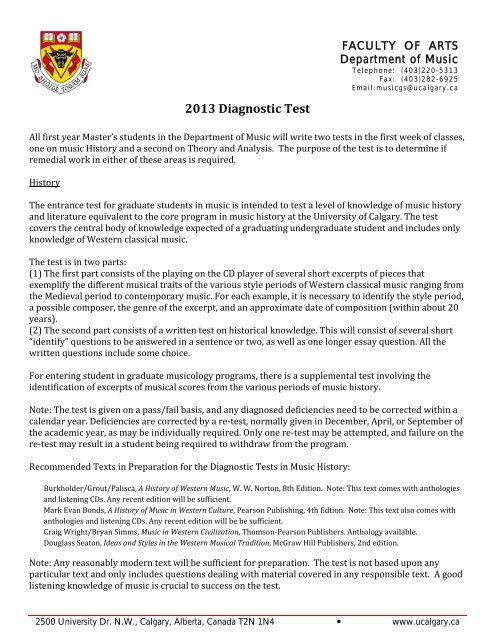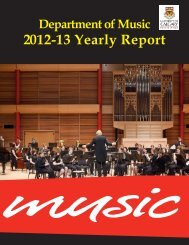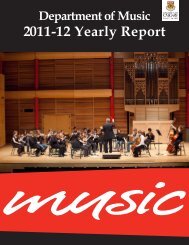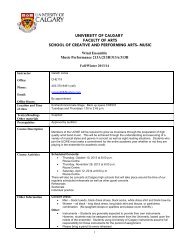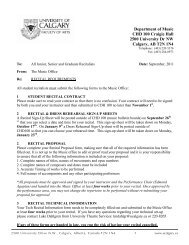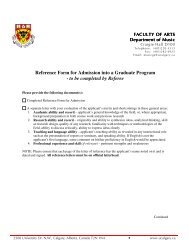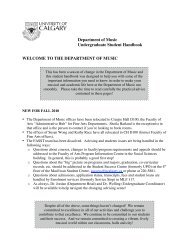2013 Diagnostic Test - Department of Music - University of Calgary
2013 Diagnostic Test - Department of Music - University of Calgary
2013 Diagnostic Test - Department of Music - University of Calgary
Create successful ePaper yourself
Turn your PDF publications into a flip-book with our unique Google optimized e-Paper software.
FACULTY OF ARTS<br />
<strong>Department</strong> <strong>of</strong> <strong>Music</strong><br />
Telephone: (403)220-5313<br />
Fax: (403)282-6925<br />
Email:musicgs@ucalgary.ca<br />
<strong>2013</strong> <strong>Diagnostic</strong> <strong>Test</strong><br />
All first year Master’s students in the <strong>Department</strong> <strong>of</strong> <strong>Music</strong> will write two tests in the first week <strong>of</strong> classes,<br />
one on music History and a second on Theory and Analysis. The purpose <strong>of</strong> the test is to determine if<br />
remedial work in either <strong>of</strong> these areas is required.<br />
History<br />
The entrance test for graduate students in music is intended to test a level <strong>of</strong> knowledge <strong>of</strong> music history<br />
and literature equivalent to the core program in music history at the <strong>University</strong> <strong>of</strong> <strong>Calgary</strong>. The test<br />
covers the central body <strong>of</strong> knowledge expected <strong>of</strong> a graduating undergraduate student and includes only<br />
knowledge <strong>of</strong> Western classical music.<br />
The test is in two parts:<br />
(1) The first part consists <strong>of</strong> the playing on the CD player <strong>of</strong> several short excerpts <strong>of</strong> pieces that<br />
exemplify the different musical traits <strong>of</strong> the various style periods <strong>of</strong> Western classical music ranging from<br />
the Medieval period to contemporary music. For each example, it is necessary to identify the style period,<br />
a possible composer, the genre <strong>of</strong> the excerpt, and an approximate date <strong>of</strong> composition (within about 20<br />
years).<br />
(2) The second part consists <strong>of</strong> a written test on historical knowledge. This will consist <strong>of</strong> several short<br />
“identify” questions to be answered in a sentence or two, as well as one longer essay question. All the<br />
written questions include some choice.<br />
For entering student in graduate musicology programs, there is a supplemental test involving the<br />
identification <strong>of</strong> excerpts <strong>of</strong> musical scores from the various periods <strong>of</strong> music history.<br />
Note: The test is given on a pass/fail basis, and any diagnosed deficiencies need to be corrected within a<br />
calendar year. Deficiencies are corrected by a re-test, normally given in December, April, or September <strong>of</strong><br />
the academic year, as may be individually required. Only one re-test may be attempted, and failure on the<br />
re-test may result in a student being required to withdraw from the program.<br />
Recommended Texts in Preparation for the <strong>Diagnostic</strong> <strong>Test</strong>s in <strong>Music</strong> History:<br />
Burkholder/Grout/Palisca, A History <strong>of</strong> Western <strong>Music</strong>, W. W. Norton, 8th Edition. Note: This text comes with anthologies<br />
and listening CDs. Any recent edition will be sufficient.<br />
Mark Evan Bonds, A History <strong>of</strong> <strong>Music</strong> in Western Culture, Pearson Publishing, 4th Edtion. Note: This text also comes with<br />
anthologies and listening CDs. Any recent edition will be be sufficient.<br />
Craig Wright/Bryan Simms, <strong>Music</strong> in Western Civilization, Thomson-Pearson Publishers. Anthology available.<br />
Douglass Seaton, Ideas and Styles in the Western <strong>Music</strong>al Tradition, McGraw Hill Publishers, 2nd edition.<br />
Note: Any reasonably modern text will be sufficient for preparation. The test is not based upon any<br />
particular text and only includes questions dealing with material covered in any responsible text. A good<br />
listening knowledge <strong>of</strong> music is crucial to success on the test.<br />
2500 <strong>University</strong> Dr. N.W., <strong>Calgary</strong>, Alberta, Canada T2N 1N4 • www.ucalgary.ca
Theory and Analysis – <strong>Diagnostic</strong> <strong>Test</strong> Outline<br />
1. Dictation: a) tonal harmonic progression, b) scales & modes, c) chord types (tonal . & early post-tonal),<br />
d) atonal melody.<br />
2. Realize a given short figured bass - with modulation.<br />
3. Harmonize a given short melody, with modulation to a remote key and back.<br />
4. Provide a formal analysis for a given movement, identifying the main keys. Include a harmonic analysis<br />
<strong>of</strong> an indicated passage. [sonata, sonata-rondo]<br />
5. Notate the harmonic series on C up to the 16th harmonic.<br />
6. Identify chord types (20th century) for the given chords.<br />
7. Pitch-class set analysis. Reduce. What is the prime form for the given collection <strong>of</strong> pitches. Identify<br />
properties <strong>of</strong> the set.<br />
8. Do a pitch-class set analysis <strong>of</strong> a given short atonal movement or section by Schoenberg or Webern.<br />
9. For a given row, notate a specified inversion, retrograde, or retrograde inversion. Identify the<br />
properties <strong>of</strong> the row – is there symmetry, is it a derived set?<br />
10. Look at three 1-page score excerpts from different late 20th century composers and briefly discuss<br />
key features - idiom, instrumentation, etc.<br />
11. Look at two score excerpts. Identify the instrument and sounding pitch for the circled notes.<br />
Translate the circled terms.<br />
12. Briefly define terms and mention a composer associated with the term: i.e. neo-romanticism,<br />
controlled aleatory, modes <strong>of</strong> limited transposition, planing, isorhythm, integral serialism, spectral<br />
composition, chance composition, texture, soundmass, micropolyphony, Fibonacci series, etc.<br />
Electroacoustic <strong>Music</strong>, Sonic Arts, Computational Media Design<br />
13. Techniques <strong>of</strong> sound synthesis. Briefly define: additive synthesis, subtractive synthesis, sampling,<br />
granular synthesis, physical modelling.<br />
14. Define the following electroacoustic music and sonic arts terms and give an example <strong>of</strong> their use. If<br />
appropriate mention a composer or researcher associated with the term: acoustic ecology,<br />
soundscape, sound object, masking, MIDI, OSC, musique concrète, elektronische Musik, computer<br />
music, acousmatic, mixed, interactive, telematic, ergonomic, etc.<br />
15. Identify 4 new electronic or digital instruments invented in the last 50 years and who invented them.<br />
Choose two and briefly describe how they are played and the impact they have had on contemporary<br />
musical practice.<br />
References:<br />
Kostka/Payne. Tonal Harmony: With an Introduction to 20th Century <strong>Music</strong>, 2003.<br />
Green, Douglas. Form in Tonal <strong>Music</strong> (Green), 1979.<br />
Aldwell/Schachter. Harmony and Voice Leading, 2002.<br />
Roig-Francoli, Miguel. Understanding Post-Tonal <strong>Music</strong>. New York: McGraw-Hill, 2008.<br />
Griffiths, Paul. Modern <strong>Music</strong>, A Concise History. rev ed. New York: Thames & Hudson,1994.<br />
Griffiths, Paul. Modern <strong>Music</strong> and After, 3rd ed. New York: Oxford, 2010.<br />
Holmes, Thom. Electronic and Experimental <strong>Music</strong>. 3rd ed. New York: Routledge, 2008


